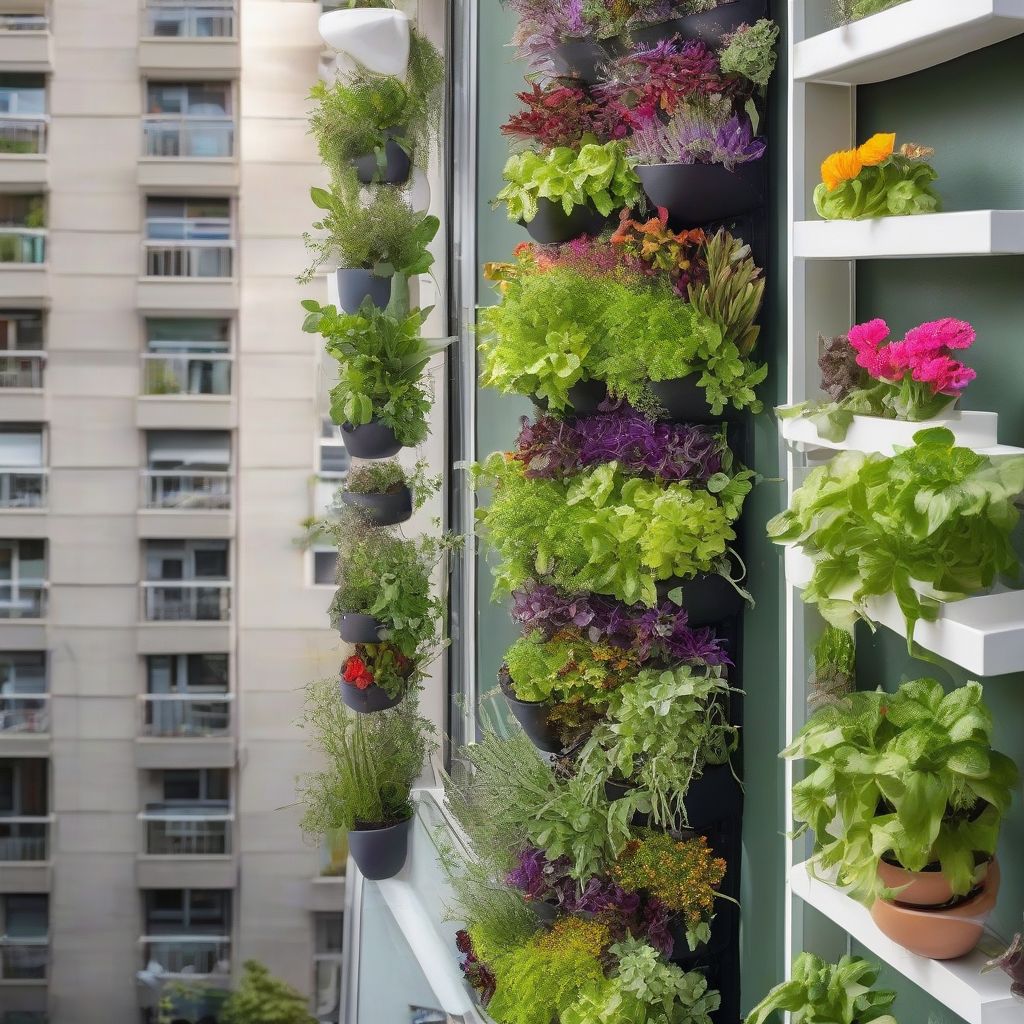Have you ever dreamt of biting into a juicy tomato warmed by the sun, freshly picked from your own garden? But then reality sets in – you live in an apartment building with only a tiny balcony. Don’t give up on your urban gardening dreams just yet! There are countless creative and efficient ways to transform even the smallest spaces into thriving edible oases. Whether you have a balcony, rooftop, or just a sunny windowsill, this guide will equip you with practical strategies and inspiring ideas to make the most of your urban garden, no matter how limited the space. Let’s get your hands dirty and turn your urban dwelling into a green haven!
Choosing the Right Gardening Method for Small Spaces
Before you sow the first seed, it’s crucial to choose a gardening method that aligns with your available space and lifestyle. Here are some popular options for urban gardening:
1. Vertical Gardening: Reaching New Heights
 Vertical Garden on Balcony
Vertical Garden on Balcony
As the name suggests, vertical gardening is all about utilizing vertical space. Think wall-mounted planters, hanging baskets overflowing with strawberries, or even repurposed shoe organizers transformed into herb gardens. This method is perfect for small balconies, patios, or even indoor walls with good sunlight.
Key Benefits:
- Maximizes Space: Ideal for areas with limited floor space.
- Aesthetically Pleasing: Creates a visually stunning green wall.
- Improved Accessibility: Easier to tend to plants at different heights.
2. Container Gardening: Versatile and Mobile
From terracotta pots to upcycled crates, container gardening offers unparalleled versatility. You can grow almost anything in containers, from dwarf fruit trees to vibrant flowers. Plus, they’re easy to move around to follow the sun or create different arrangements.
Key Benefits:
- Adaptable to Any Space: Perfect for balconies, patios, rooftops, or even windowsills.
- Control Over Soil Conditions: Allows you to tailor the soil mix to specific plant needs.
- Easy Maintenance: Containerized plants are typically easier to water and fertilize.
3. Raised Beds: Defined Boundaries for Urban Gardens
Short on ground space? No problem! Raised beds are excellent for defining your gardening area and offering better control over soil quality, drainage, and pest control. You can build them from wood, brick, or even use repurposed materials like old bathtubs.
Key Benefits:
- Improved Soil Drainage: Especially beneficial in areas with heavy clay soil.
- Easier on the Back: Reduces strain on your back compared to traditional gardening.
- Extended Growing Season: The soil in raised beds tends to warm up faster in spring.
Selecting the Ideal Plants for Your Urban Oasis
Choosing the right plants is crucial for successful urban gardening, especially in limited spaces. Consider these factors:
1. Sunlight Requirements: Assessing Your Urban Sunlight
Observe how much direct sunlight different areas of your space receive throughout the day. Most edible plants thrive in at least 6 hours of direct sunlight, while some leafy greens tolerate partial shade.
- Sun-Loving Plants (6+ hours of sunlight): Tomatoes, peppers, cucumbers, herbs like basil and rosemary.
- Partial Shade Tolerant (4-6 hours of sunlight): Lettuce, spinach, kale, Swiss chard.
2. Space Constraints: Thinking Vertically and Compactly
Opt for compact or dwarf varieties of plants that won’t overwhelm your limited space. Consider vining plants like cucumbers and beans that can climb trellises, maximizing vertical space.
3. Your Lifestyle and Preferences: Choosing Plants You’ll Love
Ultimately, the most rewarding urban gardens reflect your tastes and lifestyle. Select plants you love to eat, whether it’s a medley of fresh herbs, a colorful salad garden, or a selection of your favorite vegetables.
Essential Tips for Successful Urban Gardening
Here are some tried-and-true tips to help you make the most of your urban garden:
1. Optimize Sunlight Exposure: Reflecting and Rotating
Maximize sunlight exposure by strategically placing mirrors or reflective surfaces to bounce light towards your plants. Regularly rotate your containers to ensure even growth on all sides.
2. Water Wisely: Conservation and Efficiency
Invest in a good-quality watering can with a long spout or consider setting up a drip irrigation system to deliver water directly to the roots, minimizing waste. Water deeply but less frequently to encourage strong root development.
3. Soil Matters: Choosing the Right Mix
Use a lightweight, well-draining potting mix specifically designed for containers or raised beds. Amend the soil with compost to provide essential nutrients.
4. Embrace Companion Planting: Natural Pest Control and Growth Benefits
Strategically plant different species together that benefit each other. For example, marigolds deter pests, while basil repels insects and improves the flavor of tomatoes.
Sustainable Urban Gardening Practices: Minimizing Your Footprint
Incorporate eco-friendly practices into your urban gardening routine:
- Composting: Start a compost bin to recycle kitchen scraps and yard waste into nutrient-rich fertilizer for your plants. Learn more about the benefits of composting in urban gardening here: (https://urbangardeninghub.org/the-benefits-of-composting-in-urban-gardening/)
- Conserving Water: Collect rainwater in barrels or buckets to water your plants, reducing your reliance on tap water.
- Choosing Organic Practices: Opt for organic fertilizers, pest control methods, and seeds to minimize your environmental impact.
Creating a Thriving Community: Connecting with Fellow Urban Gardeners
Urban gardening is more than just growing food; it’s about connecting with your community and sharing the joys of fresh, homegrown produce. Join local gardening clubs, attend workshops, or start a community garden with your neighbors. Here are some resources to get you started:
- Tips for Sustainable Gardening with Limited Resources: (https://urbangardeninghub.org/tips-for-sustainable-gardening-with-limited-resources/)
- How to Create a Community Garden with Limited Resources: (https://urbangardeninghub.org/how-to-create-a-community-garden-with-limited-resources/)
Conclusion: Reaping the Rewards of Your Urban Oasis
Urban gardening, even in the smallest of spaces, offers a rewarding and fulfilling experience. It allows you to connect with nature, enjoy fresh, flavorful produce, and reduce your environmental footprint. Remember, the key is to start small, experiment with different plants and techniques, and don’t be afraid to get creative! With a little planning and effort, you can transform any urban space into a thriving green haven.
What are your favorite tips for urban gardening in limited spaces? Share your thoughts and experiences in the comments below!
[amazon bestseller=”raised garden beds”]
